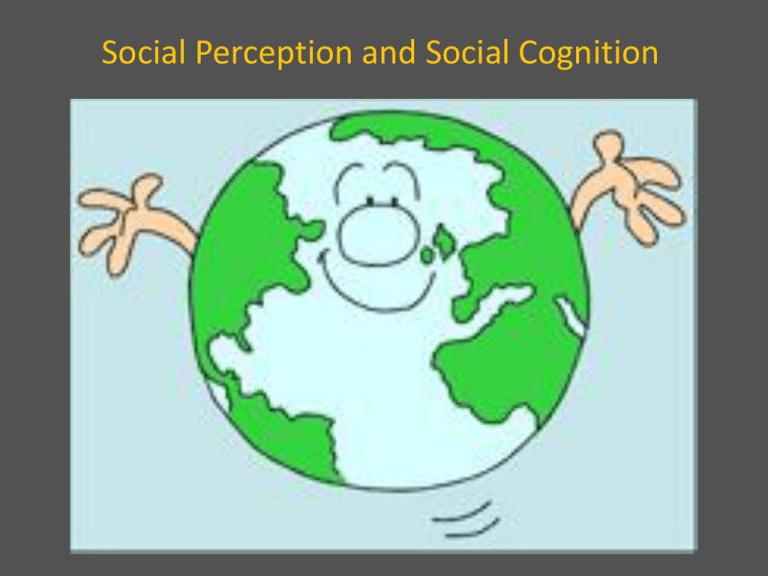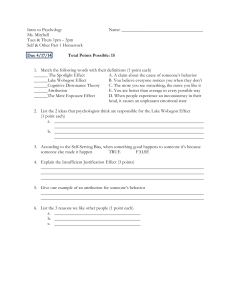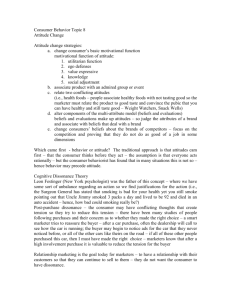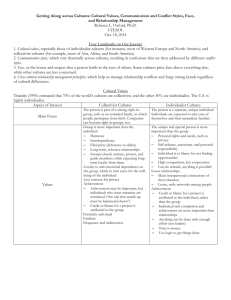social perception and cognition - Klicks-IBPsychology-Wiki
advertisement

Social Perception and Social Cognition • Social perception – the process through which we try to understand other people and ourselves – People acquire judgments, attitudes, and beliefs through socialization experiences from their culture/environment • Social cognition – the process through which we interpret, remember, and then use information about the world and ourselves – Tends to be conservative Attitude • Attitude – psychological representation of various features of the social or physical world • Abstract components of attitude: – The cognitive component – The emotional component – The behavioral component Values • Values – attitudes that reflect a principle, standard, or quality considered by the individual as most desirable or appropriate – Terminal values – Instrumental values • Hold more central position than attitude Study: Smith & Schwartz, 1997 • Independent Variable – individual values – 1. the extent to which people are independent of or dependent on groups – 2. views on prosperity and profit – 3. views on whether it is appropriate to exploit, fit in, or submit to the outside world • Dependent Variable – how groups cope with basic societal problems – Type 1. Conservatism vs. Autonomy – Type 2. Hierarchy vs. Egalitarianism – Type 3. Mastery vs. Harmony • • Original aim: to see if individual values are connected to how a group deals with a societal problem, and whether these values are different across cultures Results of the study: Groups were split into Western European, Anglo (including US), Eastern European, Islamic, East Asian, Japan, and Latin American – – – – • East Asian – high on hierarchy, low on egalitarianism and autonomy Western European – low on hierarchy, high on egalitarianism and autonomy Anglo – between East Asian and Western European samples Japan – high on harmony, high on conservatism Implications of study: this study helped the idea that, though individual values vary within a society, they do create cultural differences between regions/nations. An import observation of the study was that order is promoted in large families, verifying that social perception is highly defined by environment. Western and Non-Western Values work, achievement, striving for efficiency, consumption of material goods respect for tradition, reverence to authority, overall stability “Outlived” Western Values: • The nature of human beings is selfish • Scarcity is a primary condition of nature • Progress means growth, complexity, competition, and freedom The Cognitive Balance Theory • Balance - you and a person you like agree on something; you and a person you dislike disagree on something (A) NIKI • (A) is a person who develops evaluations (B) JULIA ROBERTS • (B) is an object, issue, or person that is being evaluated (C) CATS • (C) is an object, issue, or person that is being evaluated Cognitive Dissonance • Cognitive dissonance – psychological tensions created by a mismatch between: 1. Attitudes and behavior, or 2. Two or more decisions, or 3. Two or more attitudes • To reduce dissonance: 1. Improve your evaluation of the chosen alternative (‘Chipotle has the best burritos ever’), or 2. Lower your evaluation of the alternative not chosen (‘Qdoba is for wannabes anyways’), or 3. Just don’t think about it Psychological Dogmatism • Dogmatism – tendency to be extremely selective, rigid, and inflexible in opinions and subsequent behavior – this rigid central idea has absolute authority over the individual and causes intolerance towards others Social Attribution The process through which we seek to explain and identify the causes of the behavior of others as well as our own actions Trends in Social Attribution View positively Consider the people we groups we like; view belong to to negatively the be more people we heterogeneous dislike A face with a scar vs. same face without scar Judging people based on accents; the “TV network” accent Attribution as Locus of Control • Internal Locus of Control - events are influenced by controllable internal factors • External Locus of Control - events are influenced by uncontrollable external factors Attribution of Success and Failure Cross-culturally, the same explanations for success/failure pop up • Individual ability (‘I have the skillz’/ ‘I does not have the skillz’) • Effort (‘I studied all night’/ ‘I do not even know what class this is’) • Task difficulty (‘That test was so easy’/ ’That test blew up my brain’) Self-Perception • Correlation between collectivism and individualism and selfesteem/self-like (Chinese vs. Americans) • Private self – feelings and thoughts about oneself for oneself • Public self – concept of self in relation to others and for others Do Social Norms Affect the Way We See Our Own Body? Rich Country – NEGATIVE CORRELATION (thinner = richer) Poor Country – POSITIVE CORRELATION (thinner = poorer) Duty and Fairness in Individualist and Collectivist Cultures Morality • Justice-based view – the autonomy of the individual are most important applicable to every human being (individualist cultures) • Duty-based view – obligation to others is the basis of morality (collectivist cultures) Fairness • Merit standpoint – people have access to resources based on their accomplishments and skills • Need standpoint – people have to receive equal shares of the benefits of society regardless of their “worth” to society • Even if you have enough money to support yourself would you want to work?” Stereotypes permitting similarities between phenomena to eclipse the differences • Stereotypes – categorical assumptions that all members of a given group have a particular trait • Strong connection between interpersonal conflict and stereotyping











